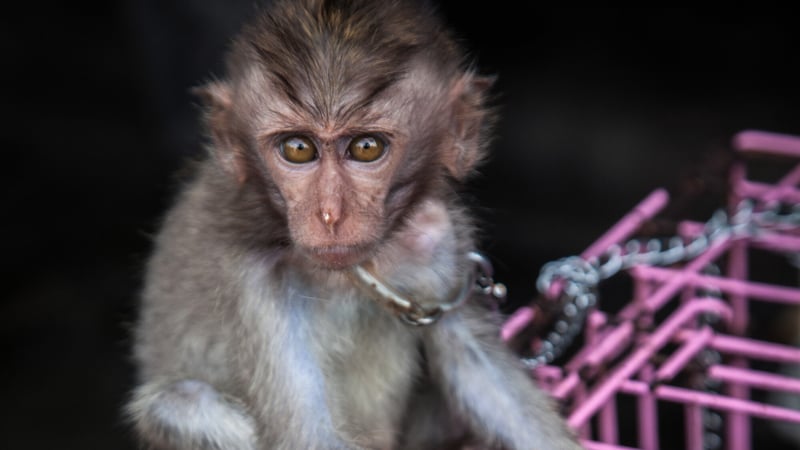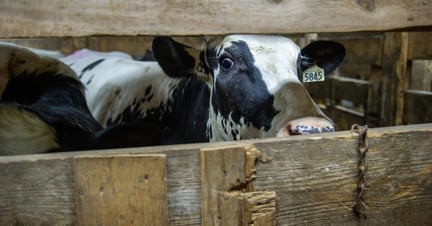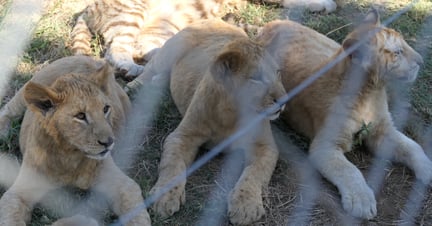
Monkey Abuse: The Cruelty Behind Cute TikTok Videos
Blog
Macaques are bathed, dressed, and ‘rescued’ for social media content. Behind these supposedly cute videos though, is a sad story of monkey abuse.
Social media is full of videos of people enjoying time with their pets. In fact, the likes of #PetTok's feel-good content is some of the most popular on the internet. Unfortunately, though, wild animals are being caught up in this trend and represented as ‘exotic pets’ rather than the traumatised, sentient beings they really are.
Macaque monkeys, in particular, are commonly found in social media videos.
What are macaque monkeys?
- Macaque monkeys include over 20 species of monkeys native primarily to Asia.
- They are found in diverse habitats such as forests, mountains, and urban areas.
- They are known for their intelligence, social structures, and complex hierarchies within their troops.
- However their adaptability, many species face threats from habitat destruction and exploitation.
SMACC's Report Uncovers the Hidden Cruelty in Online Videos
The Social Media Animal Cruelty Coalition (SMACC) — a collaboration of various animal protection organisations, including World Animal Protection — investigated over 1,200 seemingly innocent videos. These showed macaques being bathed, dressed in clothes, or ‘rescued’ and were shared across multiple social media platforms, including Facebook, YouTube, and TikTok.
The cruelty that you don't see
Behind these supposedly cute videos, though, is an all too common story of animal exploitation. The report documented over 2,800 incidents of monkey abuse and cruelty, ranging from the subtle and possibly unintentional to the deliberate and obvious.
With this report, SMACC seeks to collaborate with social media platforms to end the availability, spread, and profitability of cruelty content, and to ensure no benefits to its creation or promotion.
Discover how to recognise abusive practices involving pet macaques in social media content.
SMACC report reveals monkey abuse hidden behind ‘cute’ videos
To create the report, SMACC volunteers searched social media sites for content related to keeping macaques as pets between September 2021 and March 2023. While some videos are seemingly innocent and possibly well-intentioned (more on that below):
- over 60% of the links analysed contained overt physical abuse to these pet macaques;
- another 13% included deliberate psychological torture;
- and 12% physical abuse amounting to torture.
Perhaps more worryingly, these videos showing people abusing monkeys were permitted to remain online by social media platforms.
Regardless of the level of cruelty displayed, experts agree that keeping primates as pets is inherently cruel, and results in a multitude of issues that severely compromise their welfare. As such, the report concludes that ‘pet’ macaque videos — whether intentionally or not — are profoundly harmful.
Why you should avoid engaging with monkey content online
especially if you care about them.
1. Macaques are exploited for baby-like content
In the wild, baby macaques typically stay with their mothers for a year or longer. These long-term bonds are essential for their mental and emotional wellbeing, particularly considering these animals live their whole lives in large, multigenerational family groups.
But baby macaques are also seen as perfect victims for creating ‘cute’ content where they are treated like human babies. Videos showing macaques wearing nappies or baby clothes, being bottle-fed and bathed, and being cradled or kissed by their human “mum” or “dad” are among the most popular. While these videos may seem heartwarming and harmless to the ill-advised viewer, the animal’s welfare is actually compromised.
The macaques used for social media content are often only a few days old, isolated from the large family groups that bring them comfort. In some cases, the monkeys were recorded with their umbilical cords still attached. For complex, social animals, this can cause irreparable harm, altering their brain function, compromising their physical health, and lowering their life expectancy.

2. Monkeys endure physical and psychological suffering for videos
Another popular type of video the report identified shows macaques being forced to perform human-like behaviours, like eating food, playing with flowers, walking on their back legs, and carrying objects — all for the purpose of entertainment.
These macaques are not only forced to perform unnatural tricks, but the methods used to train and manage them are also cruel. Trainers often use negative reinforcement, like physical punishment or withholding food, when they do not comply with commands.
The monkey abuse often continues off-camera too. They’re kept in small cages, given poor or inappropriate food, and little to no social interaction. These factors combine to leave abused monkeys with severe health issues, including conditions such as diabetes and emotional trauma.
3. Monkeys fear is misinterpreted as joy
One of the difficulties SMACC, World Animal Protection, and other animal welfare workers face in challenging this content is that viewers (and some well-meaning owners) misunderstand primate behaviours and interpret their reactions from a distinctly human perspective.
Many of the videos researchers found (like the previously mentioned bathing of baby macaques or the animals-as-entertainment videos) show macaques displaying a wide ‘grin’. This is often perceived as a smile, indicating pleasure or joy. In reality, this grimace is a common primate behaviour used to express fear, nervousness, or extreme submission. Far from enjoying the experiences, these macaques were attempting to communicate their fear.
Monkeys are sentient beings that experience a rich inner world of emotions. Viewers are quick to assume that they feel joy or amusement, instead of recognising it as pain, suffering, and misery.
4. Monkeys are sold as pets for social media, fuelling the illegal wildlife trade
Many macaque species are endangered, including 35% of those most often exploited for social content, like the southern pig-tailed, long-tailed, and stump-tailed macaques.
And yet they are sold on social media. This trading, often misleadingly advertised as “adoption”, not only leads to more monkeys being abused (as they are usually purchased to be kept for entertainment or as pets) but also endangers wildlife populations.
Obtaining baby macaques from the wild often involves killing other members of their social group as they try to protect the target animal from harm. In fact, it is estimated that for every one animal traded, three animals die.
This is particularly concerning given their endangered status and can have devastating impacts on the stability and integrity of the remaining wild population.
5. Wild animals carry diseases that can be transmitted to humans
Keeping wild animals in such close proximity to humans doesn’t just pose a grave risk to the animals. It also presents a hazard to humans. Macaques carry a wide range of diseases that can be passed to humans, including Ebola, herpes, and SARS.
Any increase in the number of macaques being kept as pets raises serious public health concerns, particularly as some viruses are carried asymptomatically in macaques and can be fatal if transmitted to a human.
How to help stop fueling animal abuse online
It’s clear that ‘pet’ monkey content on social media can be profoundly harmful but we can help challenge the popularity of these photographs and videos.
We strongly urge everyone to:
- stop sharing or engaging with social media content involving these wild animals. This includes commenting, even if you are aiming to raise awareness of their plight.
- create your own post or share ours to highlight this issue without raising the profile of content creators who are fueling the abuse of monkeys.
- report the content to the relevant social media platform; you can also report any social media content involving macaques and more directly to SMACC.


